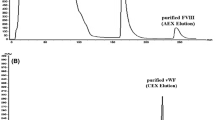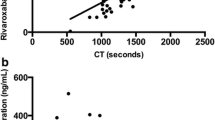Abstract
A combined product of plasma-derived factor (F)VIIa and FX (pd-FVIIa/FX; Byclot®) is currently available for the hemostatic treatment of hemophilia A and B patients with inhibitors in Japan. Limited information is available, however, on its coagulant effect in acquired hemophilia A (AHA). In the present study, we assessed the coagulant effect of pd-FVIIa/FX on impairment of coagulation potentials in AHA. The bypassing agents, pd-FVIIa/FX, recombinant FVIIa (rFVIIa), and activated prothrombin complex concentrates (aPCC) were spiked with normal plasma preincubated with anti-FVIII monoclonal antibody (AHA-model plasma), and added to plasmas from AHA patients. Clot waveform analysis (CWA) triggered by the mixture of tissue factor and ellagic acid was subsequently performed. In the AHA-model, pd-FVIIa/FX improved all of the CWA parameters in a dose-dependent manner, irrespective of epitope specificity, with significant improvements relative to rFVIIa and aPCC. The coagulant effect of pd-FVIIa/FX at 1.6 µg/mL (corresponding to 120 µg/kg infusion) at the maximum therapeutic dose was outside the normal range. Moreover, the addition of pd-FVIIa/FX led to a greater improvement in the coagulant potentials in AHA plasmas than those of rFVIIa and/or aPCC. These data suggest that pd-FVIIa/FX significantly improves the impaired coagulant potentials in AHA and is potentially therapeutic.


Similar content being viewed by others
References
Cohen AJ, Kessler CM. Acquired inhibitors. Baillieres Clin Haematol. 1996;9:331–54.
Knoebl P, Marco P, Baudo F, Collins P, Huth-Kuhne A, Nemes L, et al. Demographic and clinical data in acquired haemophilia A: results from the European Acquired Haemophilia Registry (EACH2). J Thromb Haemost. 2012;10:622–31.
Tiede A, Klamroth R, Scharf RE, Trappe RU, Holstein K, Huth-Kuhne A, et al. Prognostic factors for remission of and survival in acquired haemophilia A (AHA): results from the GTH-AH 01/2010 study. Blood. 2015;125:1091–7.
Matsumoto T, Nogami K, Ogiwara K, Shima M. A putative inhibitory mechanism in the tenase complex responsible for loss of coagulation function in acquired haemophilia A patients with anti-C2 autoantibodies. Thromb Haemost. 2012;107:288–301.
Prescott R, Nakai H, Saenko EL, et al. The inhibitor antibody response is more complex in hemophilia A patients than in most nonhemophiliacs with factor VIII autoantibodies. Recomb Kogenate Study Groups Blood. 1997;89:3663–711.
Oh JLY, Jang MJ, Huh JY, Shima M, Oh D. Characterization of anti-factor VIII antibody in a patient with acquired haemophilia A. Blood Res. 2013;48:58–62.
Huth-Kuhne A, Baudo F, Collins P, Ingerslev J, Kessler CM, Levesque H, et al. International recommendations on the diagnosis and treatment of patients with acquired haemophilia A. Haematologica. 2009;94:566–75.
Baudo F, Collins P, Huth-Kuhne A, Levesque H, Marco P, Nemes L, et al. Management of bleeding in acquired haemophilia A: results from the European Acquired Haemophilia (EACH2) Registry. Blood. 2012;120:39–46.
Tomokiyo K, Nakatomi Y, Araki T, Teshima K, Nakano H, Nakagaki T, Miyamoto S, Funatsu A, Iwanaga S. A novel therapeutic approach combining human plasma-derived Factors VIIa and X for haemophiliacs with inhibitors: evidence of a higher thrombin generation rate in vitro and more sustained haemostatic activity in vivo than obtained with factor VIIa alone. Vox Sang. 2003;85:290–9.
Nakatomi Y, Nakashima T, Gokudan S, Miyazaki H, Tsuji M, Hanada-Dateki T, Araki T, Tomokiyo K, Hamamoto T, Ogata Y. Combining FVIIa and FX into a mixture which imparts a unique thrombin generation potential to hemophilic plasma: an in vitro assessment of FVIIa/FX mixture as an alternative bypassing agent. Thromb Res. 2010;125:457–63.
Shirahata A, Fukutake K, Takamatsu J, Shima M, Hanabusa H, Mugishima H, et al. A Phase II clinical trial of a mixture of plasma-derived factor VIIa and factor X (MC710) in haemophilia patients with inhibitors: haemostatic efficacy, safety and pharmacokinetics/pharmacodynamics. Haemophilia. 2013;19:853–60.
Shinkoda Y, Shirahata A, Fukutake K, Takamatsu J, Shima M, Hanabusa H, et al. A phase III clinical trial of a mixture agent of plasma-derived factor VIIa and factor X (MC710) in haemophilia patients with inhibitors. Haemophilia. 2017;23:59–66.
Braun PJ, Givens TB, Stead AG, Beck LR, Gooch SA, Swan RJ, Fischer TJ. Properties of optical data from activated partial thromboplastin time and prothrombin time assays. Thromb Haemost. 1997;78:1079–87.
Shima M, Matsumoto T, Fukuda K, Kubota Y, Tanaka I, Nishiya K, Giles AR, Yoshioka A. The utility of activated partial thromboplastin time (aPTT) clot waveform analysis in the investigation of hemophilia A patients with very low levels of factor VIII activity (FVIII:C). Thromb Haemost. 2002;87:436–41.
Matsumoto T, Shima M, Takeyama M, Yoshida K, Tanaka I, Sakurai Y, Giles AR, Yoshioka A. The measurement of low levels of factor VIII or factor IX in hemophilia A and hemophilia B plasma by clot waveform analysis and thrombin generation assay. J Thromb Haemost. 2006;4:377–84.
Haku J, Nogami K, Matsumoto T, Ogiwara K, Shima M. Optimal monitoring of bypass therapy in haemophilia A patients with inhibitors by the use of clot waveform analysis. J Thromb Haemost. 2014;12:355–62.
Shima M, Matsumoto T, Ogiwara K. New assays for monitoring haemophilia treatment. Haemophilia. 2008;14(Suppl 3):83–92.
Matsumoto T, Nogami K, Okuda M, Shima M. Optimization of the automated, CS-2000i™ method for measuring low levels of von Willebrand factor ristocetin cofactor activity (VWF:RCo). Int J Hematol. 2015;101:126–32.
Nogami K, Matsumoto T, Tabuchi Y, Soeda T, Arai N, Kitazawa T, Shima M. Modified clot waveform analysis to measure plasma coagulation potential in the presence of the anti-factor IXa/factor X bispecific antibody emicizumab. J Thromb Haemost. 2018;16:1078–88.
Takeshima K, Smith C, Tait J, Fujikawa K. The preparation and phospholipid binding property of the C2 domain of human factor VIII. Thromb Haemost. 2003;89:788–94.
Mimms LT, Zampighi G, Nozaki Y, Tanford C, Reynolds JA. Phospholipid vesicle formation and transmembrane protein incorporation using octyl glucoside. Biochemistry. 1981;20:833–40.
Ansong C, Miles SM, Fay PJ. Epitope mapping factor VIII A2 domain by affinity-directed mass spectrometry: residues 497–510 and 584–593 comprise a discontinuous epitope for the monoclonal antibody R8B12. J Thromb Haemost. 2006;4:842–7.
Markovitz RC, Healey JF, Parker ET, Meeks SL, Lollar P. The diversity of the immune response to the A2 domain of human factor VIII. Blood. 2013;121:2785–95.
Summers RJ, Meeks SL, Healey JF, Brown HC, Parker ET, Kempton CL, Doering CB, Lollar P. Factor VIII A3 domain substitution N1922S results in hemophilia A due to domain-specific misfolding and hyposecretion of functional protein. Blood. 2011;117:3190–8.
Meeks SL, Healey JF, Parker ET, Barrow RT, Lollar P. Antihuman factor VIII C2 domain antibodies in hemophilia A mice recognize a functionally complex continuous spectrum of epitopes dominated by inhibitors of factor VIII activation. Blood. 2007;110:4234–42.
Acknowledgements
This study was supported by the research grant from KM Biologics Co., Ltd.
Author information
Authors and Affiliations
Contributions
SO: performed experiments, analyzed data, and made the figures, MT: designed the research, performed experiments, analyzed data, interpreted the data, and wrote the paper, MS: supervised this study, and KN: designed the research, interpreted the data, and wrote and edited the manuscript.
Corresponding author
Ethics declarations
Conflict of interest
TM, MS, and KN receive research support from KM Biologics, Novo Nordisk, and Takeda. TM, KN, and MS receive (consulting) honoraria from these companies. SO has no conflict of interest to declare.
Additional information
Publisher's Note
Springer Nature remains neutral with regard to jurisdictional claims in published maps and institutional affiliations.
About this article
Cite this article
Ochi, S., Takeyama, M., Shima, M. et al. Plasma-derived factors VIIa and X mixtures (Byclot®) significantly improve impairment of coagulant potential ex vivo in plasmas from acquired hemophilia A patients. Int J Hematol 111, 779–785 (2020). https://doi.org/10.1007/s12185-020-02837-6
Received:
Revised:
Accepted:
Published:
Issue Date:
DOI: https://doi.org/10.1007/s12185-020-02837-6




